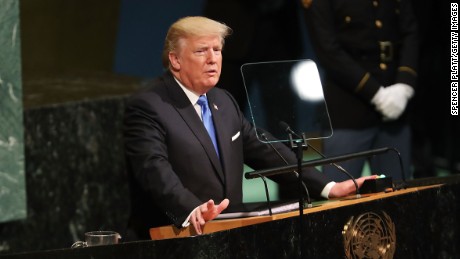Dan K. Eberhart is CEO of Canary, an independent oilfield services company in the United States. He has served as a consultant to the energy industry in North America, Asia and Africa. The opinions expressed in this commentary are his own.
President Trump has made good on his promise to put "America First." That fact is perhaps most evident in his economic policy, specifically his treatment of the US energy sector.
Trump is using America's vast oil and natural gas resources as a tool of influence around the world. The administration is joining its desire to expand America's access to overseas oil and gas markets - with the more significant aim of advancing its national security goals.
This tariff-based strategy is a far more aggressive use of energy diplomacy than we are used to seeing out of Washington and will benefit our country, both in economic growth and geopolitical power.
Indeed, failing to seize on America's energy dominance and create economic opportunities for ourselves would be a failure of leadership, especially given that the United States saw the most massive annual increase in oil and natural gas production in history last year.
As a result of the shale boom, the US is the world's largest oil producer, with output expected to average 12.4 million barrels a day this year and 13.3 million barrels a day in 2020. Likewise, America is the world's largest producer of natural gas, producing an average of 91.3 billion cubic feet of LNG a day this year and 92.7 billion cubic feet a day in 2020.
Global oil production outpaced demand by 900,000 barrels a day in the first half of the year. Last year, global oil production grew by 2.2 million barrels a day, more than double the 10-year average. The entirety of that net growth came from new US barrels, mainly light sweet crude from Permian Basin shale in west Texas and New Mexico.
As output continues to grow over the next decade, new barrels of crude and molecules of gas will need to find markets abroad. That's because US refiners, petrochemical makers and electric utilities have run out of capacity to process more American energy supplies. This is a big reason why expanding energy export markets is a priority for the Trump administration.
Trump has advanced this strategy on several fronts. He has hit bad actors like Iran and Venezuela, two big OPEC producers, with harsh sanctions that have dramatically reduced their ability to fund their activities with oil revenue. Meanwhile, Trump has helped persuade Saudi-led OPEC to continue making price-supportive supply cuts of 1.2 million barrels a day. The net effect has made room for growing US oil production, which is now singlehandedly meeting the growth in global oil demand.
This is no small feat, but it does require some political will to sustain. Trump has been criticized for keeping close ties with the Saudi leadership and Crown Prince Mohammed bin Salman, in particular, following the murder of Saudi journalist and US resident Jamal Khashoggi, including vetoing Congress's attempts to block US arms sales to Riyadh.
The administration has also maintained Obama-era sanctions on Russia that limit Moscow's long-term capacity to develop its oil reserves. It is now considering new measures that would target new Russian gas pipelines into Europe. Trump's objective is to make Europe less vulnerable to Kremlin influence while making more room for US exports of liquefied natural gas (LNG).
At present, Russia is the dominant gas supplier to Europe, accounting for nearly 40% of the market. Such dependence weakens US allies in Europe and gives Putin significant influence over the continent.
Trump thinks the US can help Europe reduce the use of Russian gas while making a buck off America's own LNG exports. Weaning the continent off Russian gas won't be easy since Russia's pipelines can typically deliver gas cheaper than US LNG can be shipped to Europe. But even modest success would be great for America, both in economic and national security terms.
More Markets & Economy Perspectives
Asia has been trickier. The US trade war with China, the world's fastest-growing energy market, has hurt American oil and gas producers. China's retaliatory tariffs on US LNG have eliminated that market for US exporters. China has also largely halted imports of US oil this year as the trade war has ramped up, yet the country has not slapped tariffs on our oil.
Vast US energy supplies remain a crucial bargaining chip -- one that Trump continues to play -- in broader trade negotiations between energy-hungry China and the US. If the net result is a fair trade deal with Beijing that includes long-term supply agreements for oil and gas, America's producers and the business community, in general, will be pleased.
India, the world's third-largest oil importer, has already begun replacing Iranian barrels with American ones after many thought New Delhi would defy US sanctions. China has also reduced its Iranian imports but has not halted them altogether. Beijing paid the price for continuing to buy Iranian oil, though, with the US blacklisting one of China's top trading firms, Zhuhai Zhenrong.
Trump's sanctions on Iran have slashed the Islamic Republic's exports to historic lows - from 2.4 million barrels a day in early 2018 to well below 500,000 barrels a day today. Iran's economy is faltering. The same goes for Venezuela, which some think could see output fall below 500,000 barrels a day by the end of this year from nearly 2 million barrels a day in 2017.
Meanwhile, the US keeps gaining market share. The International Energy Agency believes the US will account for 70% of the total increase in global oil production capacity to 2024, adding a massive 4 million barrels a day in output. That should push America past Russia in oil exports and close to Saudi Arabia.
Trump understands the current opportunity for the United States to gain the upper hand on economic and national security matters. And he is pushing it to the limit all in the name of putting America first.






















